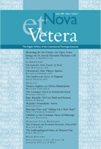One thing I hope to do for myself in my Scripture project is to take various principles that have been at play in my mind for many years and put them in order. Which ones are more fundamental? Which ones are in fact governed by others? What relationships emerge?
A strong contender for “central principle” is the notion of a “common good.” By a common good, I mean a good that can be shared among many persons without in any way being diminished or divided. Let me unpack that idea a bit.
A cookie is not a common good; it is a private good. My cookie can only be shared by breaking it into parts so that I get less cookie at the end of the deal. And when you look more closely, it turns out cookie isn’t really sharable: the part you get is a part I can’t have, and the part  I keep is a part you will never eat. What I really do when I break my cookie up is I create a bunch of smaller things, and then I keep one of them and I give others away. So I can give cookie away, but I can’t share it.
I keep is a part you will never eat. What I really do when I break my cookie up is I create a bunch of smaller things, and then I keep one of them and I give others away. So I can give cookie away, but I can’t share it.
Friendship is a common good. Not only can I share my friendship with a friend, I can’t actually have friendship without sharing it. My portion of it is not diminished when another’s is increased; instead, my portion is actually increased by sharing it more. Of course, the kind of friendship we usually have in mind when we use the word is not a perfectly common good: a person can have only a few very close friends, and even though it is perfectly shared between them there is a limit to how many people can share in it.
But this is to be expected. Goods come in different kinds, and they fall on a spectrum from purely private to most common and everywhere in between. Any time we find a common good, we’ll find that even though it is common it has its limits. It will be more or less sharable, and more or less diminished when it is shared. The common good of the United States of America, for example, even though it is a great good and much more “sharable without diminution” than my personal friendships, can only extend to its people; the good folks in Argentina are excluded.
The reason is simply that goods fall on a range from less good to most good and everywhere in between. A good that is better is, so to speak, more powerfully  good. As a hotter fire not only heats a person up more but also heats up more people, so a better good is not only better for a person but is a good for more people: it is more common. So more common goods are better goods, and the better a good is the more common it will be.
good. As a hotter fire not only heats a person up more but also heats up more people, so a better good is not only better for a person but is a good for more people: it is more common. So more common goods are better goods, and the better a good is the more common it will be.
The only absolutely common good is the good that is goodness itself: God. Every creature in the entire universe has God as its good; in fact, every conceivable creature in every conceivable universe would have God as its good, because his goodness is never used up, so to speak, by what he has created. God is not only the good of every person, but he is more intimately the good of each person than that person’s best friends. God can be not only the friend but even the lover of every person in creation, and it never dilutes, the way human friendship dilutes when spread too far.
But revelation tells us there is even more. Even though reason rightly tells us that there is only one God, one being that is the source of every being and one good that is the good of every good, still revelation tells us that three persons are this one being. The word “share” explodes at this point, because the three persons are each identical with the divine being rather than sharing in it, but something happens that is more “sharing” than sharing itself. Rather than three friends who each have a share in the group’s friendship, and rather than three citizens who each have a share in the country’s peace, there are three persons who are each identical with the divine goodness without being identical to each other.
Fallen creatures that we are, this is the opposite of what we expected. We listened to the voice of the serpent, who whispered to us that God clings jealously to his divinity, that he wants no one but himself to be like God. But when the second person of the Trinity at last came to respond to the serpent, he did not think equality with God something to be grasped at, to be clutched like a merely private good: rather, he emptied himself, and took the form of a servant. The Incarnation of the Word revealed the Word’s eternal way of being, as the unimaginably best and therefore inconceivably communicable good.
Our reason cannot grasp it, and our sinful inclinations run counter to it, but the revelation of the Trinity tells us clearly: Goodness is even better than we thought.






